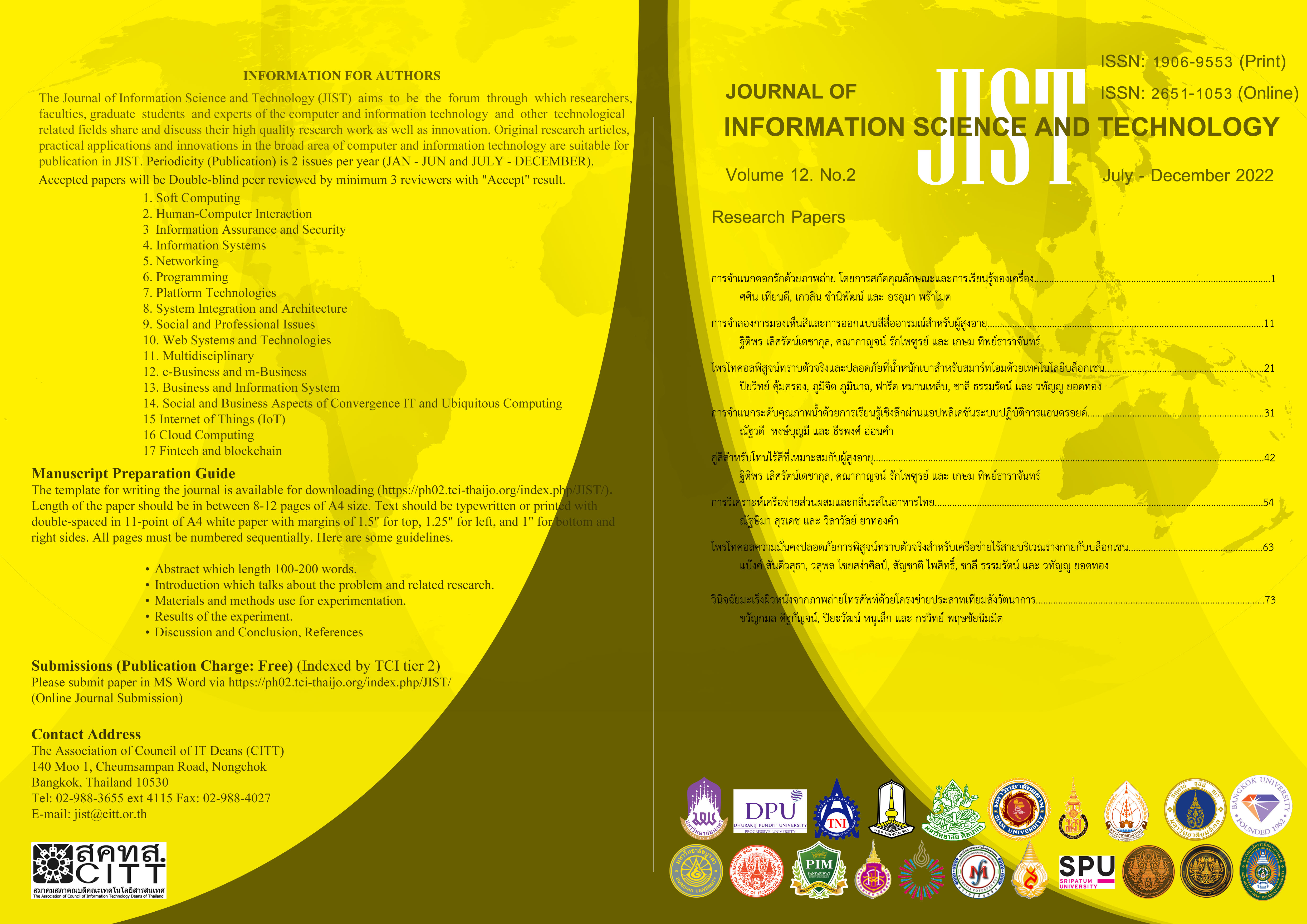Aging Color Vision Simulation and Emotional Color Design
Main Article Content
Abstract
In the aged society, more than half of elderly people suffer from cataracts. This research aimed to simulate color vision and vision of color brightness levels in elderly patients with high-level cataracts using yellow acrylic and blurry filters and a set of 180 test colors from the “Color Image Scale”. These colors help in connecting inherent emotions for color design that is suitable for the elderly. The study resulted in color groups that the elderly could clearly see and see closely to normal vision people which are the colors in yellow, orange, red and green tones. Therefore, designers can choose colors in these color groups and investigate with emotion or impression of color combination in the “Color Image Scale” and the contrast ratio for good visibility and creation of emotional perception for the elderly. This will be useful for communicating information, product development and improving quality of life for the elderly.
Article Details
This work is licensed under a Creative Commons Attribution-NonCommercial-NoDerivatives 4.0 International License.
I/we certify that I/we have participated sufficiently in the intellectual content, conception and design of this work or the analysis and interpretation of the data (when applicable), as well as the writing of the manuscript, to take public responsibility for it and have agreed to have my/our name listed as a contributor. I/we believe the manuscript represents valid work. Neither this manuscript nor one with substantially similar content under my/our authorship has been published or is being considered for publication elsewhere, except as described in the covering letter. I/we certify that all the data collected during the study is presented in this manuscript and no data from the study has been or will be published separately. I/we attest that, if requested by the editors, I/we will provide the data/information or will cooperate fully in obtaining and providing the data/information on which the manuscript is based, for examination by the editors or their assignees. Financial interests, direct or indirect, that exist or may be perceived to exist for individual contributors in connection with the content of this paper have been disclosed in the cover letter. Sources of outside support of the project are named in the cover letter.
I/We hereby transfer(s), assign(s), or otherwise convey(s) all copyright ownership, including any and all rights incidental thereto, exclusively to the Journal, in the event that such work is published by the Journal. The Journal shall own the work, including 1) copyright; 2) the right to grant permission to republish the article in whole or in part, with or without fee; 3) the right to produce preprints or reprints and translate into languages other than English for sale or free distribution; and 4) the right to republish the work in a collection of articles in any other mechanical or electronic format.
We give the rights to the corresponding author to make necessary changes as per the request of the journal, do the rest of the correspondence on our behalf and he/she will act as the guarantor for the manuscript on our behalf.
All persons who have made substantial contributions to the work reported in the manuscript, but who are not contributors, are named in the Acknowledgment and have given me/us their written permission to be named. If I/we do not include an Acknowledgment that means I/we have not received substantial contributions from non-contributors and no contributor has been omitted.
References
Art Therapy, “Color Therapy & Healing – An Introduction,” arttherapyblog.com. [Online]. Available: http://www.arttherapyblog.com/online/color-therapy-healing-an-introduction. [Accessed Mar. 11, 2022].
National Legislative Assembly of Thailand, “Aged Society : National Agenda,” 2018. [Online]. Available: https://www.senate.go.th/document/Ext17951/17951564_0004.PDF [Accessed Mar. 11, 2022].
Japanese Society for Cataract Research, “Cataract Self-Diagnosis Test,” jscr.net. [Online]. Available: http://www.jscr.net/ippan/page-010.html. [Accessed Mar. 11, 2022].
L. Pukkhaow, P. Saenprasarn, and K. Huttrungsri, “Developing model of generosity participatory nursing among cataract surgery patients as of Swanson’s theory, Pathum thani hospital,” Journal of Health Science, vol. 29, no. 5, pp. 864–875, Sep. - Oct. 2020.
H. Nagumo, New Color Image Chart. Tokyo, Japan: Graphic-sha, 2016.
N. Sungvorawongphana, R. Subgranon, P. Pungrassamee, C. Sumngern, and T. Obama, “The color vision of elderly under difference illuminance,” The Journal of Faculty of Nursing Burapha University, vol. 23, no. 1, pp. 13–25, Jan. - Mar. 2015.
J. Kawaguchi, S. Shoyama, T. Danno, and Y. Tochihara, “Effect of color discrimination ability and visual acuity in their living environments of the elderly,” Journal of Human and Living Environment, vol. 12, no. 1, pp. 21–26, 2005.
C. Chivaran, M. Zallio, S. Waller, and P. J. Clarkson, “Visual accessibility and inclusion An exploratory study to understand visual accessibility in the built environment,” SMART ACCESSIBILITY 2021 : The Sixth International Conference on Universal Accessibility in the Internet of Things and Smart Environments, 2021, pp. 1–7.
Suwa Branch of the Youth Committee of the Architects Association of Nagano Prefecture, “Elderly-friendly Color Plan,” 2001. [Online]. Available: https://www.arcsuwa.com/wp-content/uploads/2020/03/koureisyaniyasasii.pdf [Accessed Mar. 11, 2022].
University of Cambridge, “Clari-Fi,” [Online]. Available: http://clarifi.inclusivedesigntoolkit.com/screenshot_intro. [Accessed Mar. 11, 2022].
University of Cambridge, “Impairment Simulator Software,” [Online]. Available: http://www.inclusivedesigntoolkit.com/simsoftware/simsoftware.html. [Accessed Mar. 11, 2022].
I. Kei, “Color universal design : Towards barrier-free design for diverse color visions,” Journal of Information Processing and Management, vol. 55, no. 5, pp. 307–317, Aug. 2012.
S. Ishihara, Tests for Colour-Blindness. Tokyo, Japan: Kanehara, 1972.
M. Yamamoto, Y.-H. Lim, N. Aoki, and H. Kobayashi, “On the preferred reproduction of flesh color in Japan and south Korea, investigated for all generation,” Journal of The Society of Photographic Science and Technology of Japan, vol. 65, no. 5, pp. 363–368, Sep. 2002.
World Wide Web Consortium, “Web Content Accessibility Guide
lines (WCAG) 2.1,” 2018. [Online]. Available: https://www.w3.org/TR/WCAG21. [Accessed Mar. 11, 2022].
M. A. Jadkowski, “Understanding Recommended Color Contrast,” eldertech.org, Jan. 11, 2017. [Online]. Available: https://eldertech.org/color-contrast-apps-for-older-adults. [Accessed Mar. 11, 2022].



